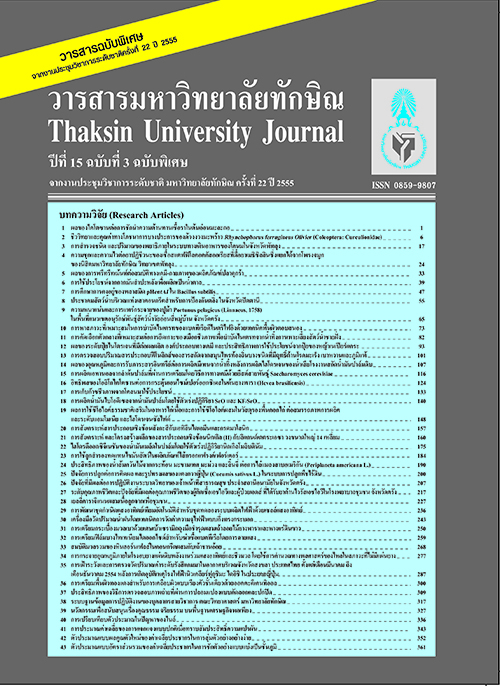การใช้ประโยชน์จากกากมันสำปะหลังเพื่อผลิตเป็นน้ำตาล
Main Article Content
Abstract
น้ำตาลเป็นสารตั้งต้นที่สำคัญในการนำมาใช้ประโยชน์ในอุตสาหกรรมหลายประเภท เช่น อาหาร เครื่องดื่ม รวมทั้งสามารถนำมาผลิตเป็นพลังงานทดแทน เช่น เอทานอล โดยงานวิจัยนี้มีวัตถุประสงค์ เพื่อศึกษาทดลองนำกาก มันสำปะหลังจากอุตสาหกรรมแป้งมาผลิตเป็นน้ำตาล จากการสำรวจข้อมูลเบื้องต้นพบว่า ในปี 2554 ประเทศไทย มีพื้นที่ปลูกมันสำปะหลังประมาณ 7.17 ล้านไร่ มีผลผลิตมันสำปะหลัง 21.31 ล้านตัน [1] และกากมันสำปะหลัง เหลือทิ้งจากอุตสาหกรรมแป้งประมาณ 2.36 ล้านตันต่อปี ซึ่งสามารถนำกากมันสำปะหลังที่ความเข้มข้น 100 กรัม ต่อลิตร มาแปรรูปเป็นน้ำตาลด้วยการดำเนินงานแบบต่อเนื่องเป็น 2 ขั้นตอน คือขั้นแรกคือใช้เอนไซม์ย่อยเซลลูโลส (CTec 2) 1 มิลลิลิตร ในการย่อยเวลา 6 ชั่วโมง ให้น้ำตาลรีดิวซ์ และน้ำตาลทั้งหมด 8.21, 15.77 กรัมต่อลิตร และขั้นตอนที่สองเอนไซม์แอลฟาอะไมเลส ใช้เวลาในการย่อย 2 ชั่วโมง ให้น้ำตาลรีดิวซ์ และน้ำตาลทั้งหมด18.24, 73.56 กรัมต่อลิตร และหลังจากนั้นใช้เอนไซม์กลูโคอะไมเลส ใช้เวลาในการเปลี่ยนแป้งเป็นน้ำตาล 12 ชั่วโมง ให้น้ำตาลรีดิวซ์และน้ำตาลทั้งหมดสูงที่สุด 65.80 , 73.56 กรัมต่อลิตรจากการศึกษาทดลองครั้งนี้เป็นการสร้างมูลค่า ลดปัญหาทางสิ่งแวดล้อม และลดภาวะโลกร้อนด้วยการนำของเหลือมาใช้ให้เกิดประโยชน์สูงสุด
Sugar is very important raw material of many industries i.e. food, beverage and renewable energy. This research aim to study utilization of cassava solid waste for sugar product. By the year 2011, Thailand produced fresh cassava 21.31 million-ton from 7.17 million-rai of farm and there were cassava solid waste from starch industries about 2.36 million-ton per year. The cassava solid waste (100 g/l) changed to sugar by 2 steps of hydrolytic (1) enzymatic hydrolytic of cellulose by CTec 2 (1 ml) for 6 hours to produced reducing sugar and total sugar 8.21, 15.77 g/l (2) -amylase hydrolytic (activity; 6 KNU/100g starch) to produced reducing sugar and total sugar 18.24, 73.56 g/l for 2 hours. After that Glucoamylase (activity; 129 AGU/100 g starch) changed starch to sugar or 12 hours to produce 65.80 g/l of reducing sugar and 73.56 g/l of total sugar. This study made valueadding in the industrial processing, decrease environmental problem and reduce global warming crisis by optimized utilization of cassava solid waste from starch industries.


